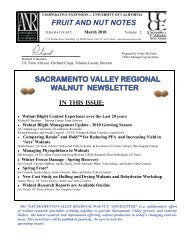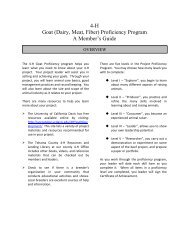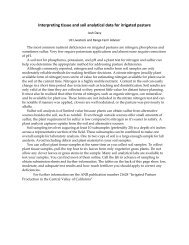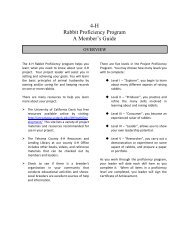Larry Schwankl's Presentation, Microirrigation Maintenance and ...
Larry Schwankl's Presentation, Microirrigation Maintenance and ...
Larry Schwankl's Presentation, Microirrigation Maintenance and ...
Create successful ePaper yourself
Turn your PDF publications into a flip-book with our unique Google optimized e-Paper software.
<strong>Microirrigation</strong> <strong>Maintenance</strong>& Chemigation Uniformity<strong>Larry</strong> SchwanklUC Cooperative Extensionschwankl@uckac.edu 559-646646-65696569website: www.schwankl.uckac.edu
Clogging of <strong>Microirrigation</strong> SystemsSource: Physical Clogging - Particulates
Clogging of <strong>Microirrigation</strong> SystemsSource: Physical Clogging - ParticulatesSolution: Filtration
Filters:• Screen, disk, <strong>and</strong> s<strong>and</strong> media filters areall available.• They all filter to the same degreeBUTthey req. different frequency of cleaning.
Clogging of <strong>Microirrigation</strong> SystemsSource: Chemical Precipitates• Lime (calcium carbonate) <strong>and</strong> iron arethe most common problems.
Chemical Precipitate Clogging of<strong>Microirrigation</strong> SystemsWater quality levels of concern:• Calcium: pH > 7.5 <strong>and</strong> 2.0 meq/l (120ppm) of bicarbonate• Iron: pH > 4.0 <strong>and</strong> 0.5 ppm iron
Clogging of <strong>Microirrigation</strong> SystemsSource: LimeSolution: pH Control (Acidification)+filtration
Dealing with Iron Precipitation:1. Precipitate iron in a pond / reservoir
Dealing with Iron Precipitation:1. Precipitate iron in a pond / reservoir2. Chemicals (e.g. phosphonic acid,phosphonate) may keep iron insolution
Clogging of <strong>Microirrigation</strong> SystemsSource: Biological Sources
Clogging of <strong>Microirrigation</strong> SystemsSource: Biological SourcesSolution: Filtration (usually media filters)+Biocide
Test for chlorine using a pool / spa test kit
Flushing of microirrigation systems:• Silts <strong>and</strong> clay particles pass through even thebest filters.
Flushing• Silts <strong>and</strong> clay particles pass through even thebest filters.• Need to flush the system - mainlines, submains,<strong>and</strong> laterals (in that order).
Flushing• Silts <strong>and</strong> clay particles pass through even thebest filters.• Need to flush the system - mainlines, submains,<strong>and</strong> laterals (in that order).• Flush laterals by h<strong>and</strong> or use automatic flushing endcaps.
Chemigation Uniformity inDrip Irrigation Systems
Uniform ChemigationWe want to have the material injected into the dripsystem to be applied as evenly (uniformly) as thewater applied by the drip irrigation system.
Uniform ChemigationFirst, it is important to remember that once youstart injecting, the injected material doesn’timmediately start coming out of all the dripemitters.•It takes time for the injected material (<strong>and</strong> thewater) to travel through the drip irrigationsystem.
Uniform ChemigationWhat happens when we stop the injection?What happens when we stop the injection?.
Uniform ChemigationIt takes at least as long for most of the chemical toclear from the drip lateral as it took it to initiallymove through the lateral.To takes a long time for all the chemical to clearout of the drip lateral.
Uniform ChemigationWe also need to account for the time it takes forthe injected chemical to move through theunderground pipelines.How do we do this?
Uniform ChemigationThe easiest way to determine travel times ofchemicals (<strong>and</strong> water) through a drip system:•Inject Inject chlorine (at about 10 - 20 ppm) intothe drip system <strong>and</strong> follow its movementthrough the drip system.•It is easy to spot when chlorine reaches anypoint by testing the water with a pool/spatest kit.
Uniform ChemigationWhat if you don’t t have the post-injection period ofclean water irrigation?
Chemigation uniformity in a drip lateral (500-feet long with 1-gallon 1per hour dripemitters installed at 5-foot 5intervals) for various injection time periods <strong>and</strong> variouspost-injection clean water irrigations. The water / chemical travel time to reach theend of the drip lateral was 25 minutes.Injection Time Post-Injection Irrigation Relative Uniformity(min)Time (min)50 50 10050 0 2525 25 9525 0 11
Uniform ChemigationWhat happens during chemigation in acommercial scale vineyard or orchard?The following table shows the characteristics(pipeline length <strong>and</strong> drip lateral lengths) <strong>and</strong>water/chemical travel times for 6 commercialsystems.
Water / chemical travel times through the pipelines <strong>and</strong> driplateral lines for the vineyard <strong>and</strong> orchard field sites evaluated.Site Mainline <strong>and</strong> Submain Lateral Line Total TravelTravel Time (min.) Length (ft) Travel Time (min.) Length (ft) Time (min)1 22 1000 10 175 322 30 1500 10 340 403 65 5000 10 340 754 15 1400 30 630 455 8 700 25 625 336 17 800 28 600 45
Uniform ChemigationIn summary:•There There is no st<strong>and</strong>ard total travel time througha drip system. The travel times ranged from30 to 75 minutes.•You You need to test (using the chlorine traveltime test) the drip system you’re concernedwith. You only need to do this once - thenyou know the travel time through the dripsystem.
Chemigation Uniformity in DripIrrigation Systems• Trees & vines - injections should last at least 1 hour,<strong>and</strong> at least 1 hour (longer is better) of clean waterirrigation should follow it.• Row crop drip - injections should be at least 2 hours inlength, <strong>and</strong> there should be at least 2 hours (longer isbetter) of clean water irrigation following injection.
Questions?<strong>Larry</strong> Schwankl559-646646-65696569 e-mail: eschwankl@uckac.eduFor Powerpoint presentation, go to:http://www.schwankl.uckac.edu










